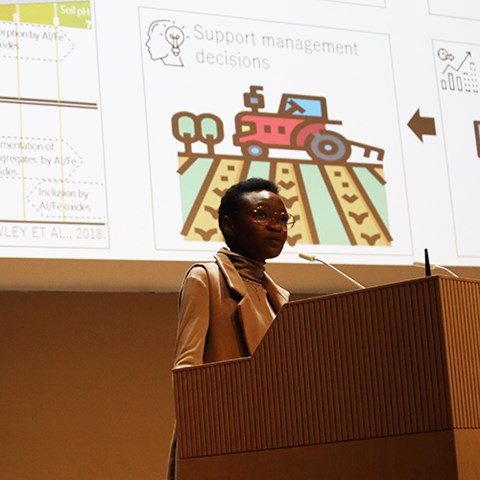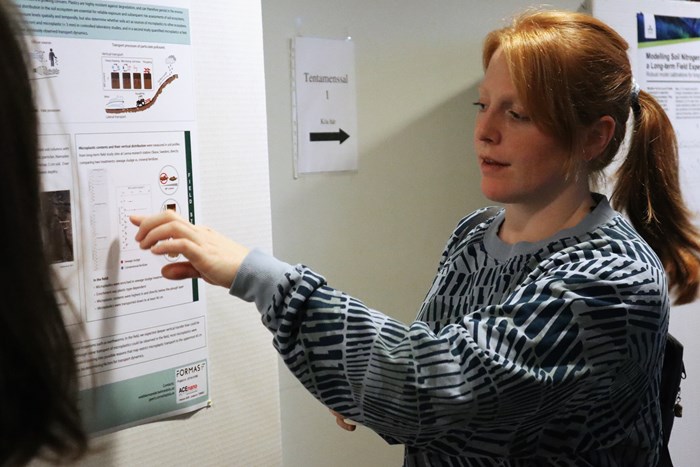PhD training in Soil Science

The department of Soil and Environment offers PhD training in Soil Science. A PhD program is four years (240 hp) of which the major part (210 hp) consist of individual research and writing of a PhD thesis.
To qualify for postgraduate education, a degree at advanced level is required or at least four years full-time studies, of which at least one year at advanced level. To be admitted to postgraduate studies in Soil Science, a minimum of 60 credits in Soil Science or equivalent is required.
PhD candidate positions are advertised at Jobs and vacancies at SLU.
In order to enhance the quality in graduate education the department is a joint organizer of the graduate school Focus on Soils and Water in collaboration with other departments at SLU.
General information about postgraduate education at SLU you can find both on the external web and at the staff web.
Documents and instructions for PhD education
Doctoral education at SLU (from 2013-01-01)
Faculty guidelines before 2013-01-01
Study plan Soil Science for PhD students accepted after 2019
(Study plan in Soil Science for PhD students accepted from 2013-01-01, in Swedish)
(Study plan in Soil Science for PhD students accepted before 2013-01-01, in Swedish)
Tips and advice from the från Editorial Committee to those who are writing a PhD Thesis
Application for admission - PhD education
Pre-requisites
The general requirement for becoming a PhD student at the department of Soil and Environment is that you have a BSc in a relevant natural science discipline and at least one more year of university studies on a more advanced level like MSc. If you do not have a higher degree than BSc you also need to have completed an independent study of at least 15 hp at a higher level than BSc.
Supervision and selection
Only PhD students that can be guaranteed supervision can be accepted. Selection of applicants are made on a competative basis where the candidates capacity to succesfully complete postgraduate studies are evaluated.
Financing
According to the Swedish decree of higher education funding for the complete education (4 years effective studies) should be available and the candidate should be employed as a doctorate student.
Feasibility of the PhD project
The board for postgraduate studies makes an assessment of the application based on PhD candidate qualifications, possibilities for supervision, quality of suggested reserach, available funds and suggested time plan.
Application
The application for admission is prepared by the applicant in collaboration with the main supervisor.
Documents that should be submitted to the director of post-gradiuate reserach electronically includes:
- Individual study plan (ISP)
- Form 2: Recommendation of admission
- Copy of external funding contracts
- CV of the applicant
- Study records that proves that you fulfill the formal requirements and English proficiency
- A copy of the advertised announcement of the PhD position
- The supervisor's motivation for the choice of candidate including a brief description of the selection process
Application process
The application should be sent to the director of post-graduate studies for a pre-evaluation at least three weeks before the meeting of the board for postgraduate studies at the department (see calendar at the internal homepage).
The application is considered by the board for postgraduate studies and subsequently approved by the head of department.
Please note that the application has to be approved by the department before it is passed on to the faculty. It is the faculty that takes the final decision on admission.
PhD project monitoring
PhD Defence - preparations
PhD students at the Department
Ylva Bellander
Towards better risk assessment of cadmium in agricultural soil for sustainable nutrient management
Karin Andersson
Increased nitrogen efficiency from cattle slurry – effects of slurry characteristics, slurry treatments and application techniques
Elisabeth Bölenius
Spatial distribution of soil physical properties
Miyanda Chilipamushi
The effects of aluminum oxides and soil structure on the potential of carbon sequestration in Swedish agricultural soil
Louis Dufour
Response of microbial physiology to change in land uses: a bioenergetics approach
Tamlyn Gangiah
Exploring nitrogen cycling related traits of boreal forest soil biota using metatranscriptomic markers
Peter Garamszegi
Invasive earthworms in northern Scandinavia; effects on soil microorganisms and carbon dynamics
Tove Florén
Imogolite-type nanoparticles in the environment – characterization, adsorption, and biogeochemical significance
Sara Grolander
Solubility and plant uptake of radionuclides and trace elements in soils
Lukas Hallberg
Hydrological and Biogeochemical functioning of two-stage ditches in Sweden
Reza Hosseinpour
Post-tillage evolution of soil structural pore space: measurements and modelling
Johan Iwald
Spatial and temporal trends in soil acidity and carbon pools in Swedish forest soils – evaluation of data from the Swedish Forest Soil Inventory
Louise Malmquist
Potential and boundaries for resilient water management in agricultural landscapes under climate change
Wiebke Mareile Heinze
Occurrence and fate of plastics in agricultural soils in Sweden
Emmanuel Muteba Ngonga
Water use efficiency in rainfed cereal legume systems, Southern Africa
Jelena Rakovic
Consequences of the future bioeconomy on Nordic surface waters with a focus on phosphorous in Swedish agricultural streams
Erica Packard
Exploring the function and role of ectomycorrhizal decomposers
David Nimblad Svensson
Modelling Cover Crop services and disservices in a changing climate: The trade-off between crop yield, nitrogen losses and carbon sequestration in arable land
Bradley Sparkes
Diversified cropping systems: Synergies and trade-offs of soil carbon and nitrogen cycling
Getachew Gemtesa Tiruneh
Market driven afforestation – trajectories in environmental sustainability under land-use intensification
Tamlyn Gangiah
Exploring nitrogen cycling related traits of boreal forest soil biota using metatranscriptomic markers
Rebecca ter Borg
Bioturbation by earthworms in Sweden: impacts of climate and land use
Dissertations
Dissertations at the Department of Soil and Environment
(also includes theses from the previous Department of Soil Sciences and the Department of Forest Soils 2002-2007)
Licentiate theses at at the Department of Soil and Environment
Contact
lisbet.lewan@slu.se 018-67 26 29
